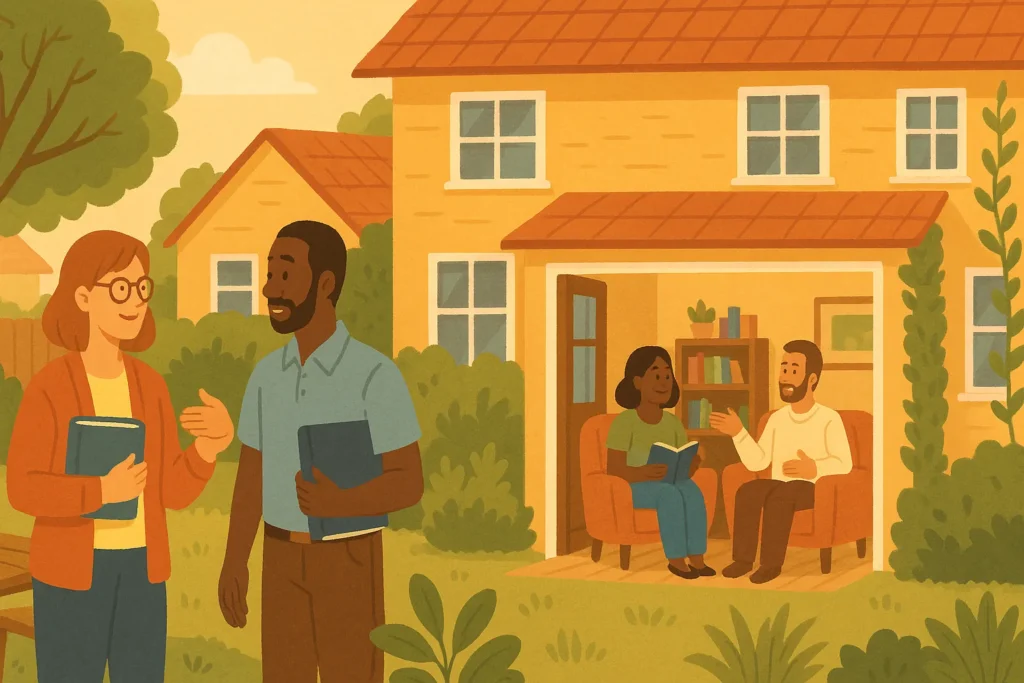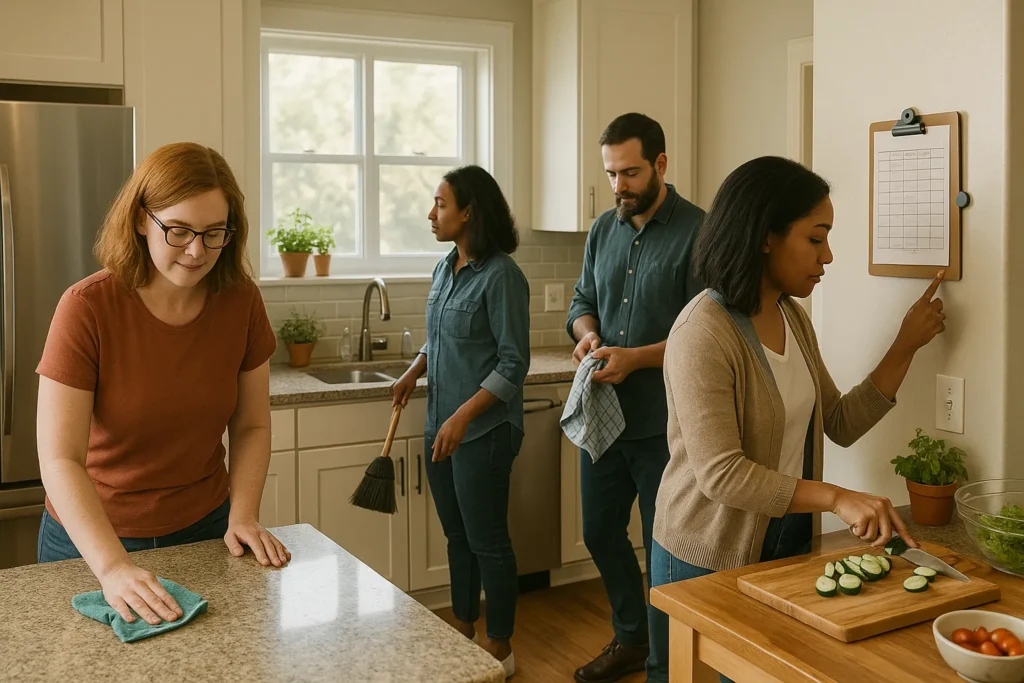Living in a teacher house share could be one of the most exciting and memorable times of your life. It could also be a nightmare, especially when you’ve worked all day and just want to sleep, but your roommate has her friends over until 2am (it happens all the time).
Don’t worry, we’ll give you the entire scoop based on our experience in the industry. We’ll even share some interesting tidbits we’ve learned from researching reviews and conducting interviews with real teachers living abroad.
In this article, we’ll explore what makes shared living work for teachers, what can create friction, and how to manage both. We’ll discuss setting boundaries, managing routines, and making the most of a living situation built around shared experience.
Ready? Let’s get started.
Why Do Teachers Choose to Live Together?
Teachers often choose to live together to share expenses, align schedules, and provide mutual support. This setup gives you financial relief, easier routines, and the comfort of living with people who know what teaching really feels like.

Here, we’ll talk about why shared living is such a popular choice. From saving money to finding a rhythm and having people around who get it, it’s a setup that works for a lot of teachers.
It helps you afford more
If you’re working in a big city or just starting out, paying for rent, bills, and food on a teacher’s salary can feel impossible. Splitting those costs with others gives you more breathing room. You might even live closer to school, cut down your commute, or save up for something bigger. When the basics cost less, everything else feels a bit more manageable.
You’re on the same schedule
There’s something comforting about not needing to explain your routine. When you live with other teachers, everyone gets why you’re eating cereal at 6 am or doing lesson plans at the kitchen table on Sunday night. You don’t need to tiptoe around housemates who live totally different lives.
You don’t have to explain your day
After a hard day, it’s a relief to walk in the door and be met with quiet understanding. Maybe your class was wild or your lesson totally flopped. Either way, your housemate has probably been there.
You can vent without over-explaining, or just sit in silence with someone who understands. It really helps just knowing someone else gets what you’re going through, especially after one of those exhausting days.
Shared living comes with plenty of comfort, but it also tests your limits when it comes to space and boundaries. Let’s talk next about how to handle that without things getting awkward.
What’s It Really Like Living With Other Teachers?
Living with other teachers gives you a sense of shared purpose and support, but it also brings unique challenges. The biggest benefit is that you’re surrounded by people who understand your schedule, your stress, and your sense of humour. But daily life together can test patience, especially when personal space and school life start to overlap.

Let’s look at what it feels like day to day when your housemates are also your colleagues in the trenches.
Mornings are fast-paced but manageable
Everyone’s on the same clock, which means mornings can get hectic. Sharing one bathroom, a kettle, and the kitchen bench teaches you to move quickly and speak up when you need time (or hot water). Over time, you’ll get into a rhythm that works, even if it includes brushing your teeth while someone reheats porridge.
Sundays are quietly communal
Teacher house shares often fall into the same weekend rhythm. Sundays are for admin, marking, and planning, even if no one talks about it. You might be spread out across the house with open laptops and coffee mugs (it feels a bit like a silent study session from uni, only now you’re preparing lessons instead of cramming for exams). It’s not loud, but it’s still supportive.
Shared space needs a quiet structure
School talk has a way of spilling into dinner chats or weekend mornings. It helps to create a few unspoken rules that keep the home feeling like home. Small habits such as keeping lesson plans out of shared areas or pausing school chat during meals go a long way in keeping the peace. Everyone needs time to disconnect, even in a house full of people who understand.
The routines can work beautifully if everyone’s respectful. Next, we’ll get into simple ways to build that respect with habits and communication that actually stick.
How Do You Keep Things Running Smoothly?
When you’re living with other teachers, the difference between a supportive home and a stressful one often comes down to how you handle the small stuff. A little structure early on saves a lot of stress later.

Here’s what can help you keep things calm, fair, and friendly.
- Talk early and clearly: Before routines settle in, have a quick chat about cleaning, shared areas, and when it’s okay to have friends over. It’s easier to agree on the basics now than to fix misunderstandings later. If something matters to you, like keeping the kitchen tidy or having quiet mornings, say so upfront.
- Say things before they build up: Small annoyances can grow quickly when you’re too tired to deal with them. Bring things up while they’re still easy to talk about. Use calm words and explain how something affects you. That makes your house feel more open, where everyone can speak honestly and listen without taking things personally.
- Make room to switch off: Even with shared routines, you all need time to yourself. Suggest ways to make the living space feel calm, like pausing school talk during dinner or keeping marking to your room. These small things help everyone unwind after a long day.
This kind of respect in shared living doesn’t always happen by accident. It starts with a few thoughtful choices and small conversations. You can see how others have created that in Stories of Triumph and Growth, where shared homes became spaces that helped people grow.
Next, we’ll dive into the wild, funny and unexpectedly sweet moments that make teacher house shares memorable.
What Surprises You When Teachers Live Together?
You’ll be surprised by how much support, laughter and comfort can come from sharing a home with other teachers. It often becomes the thing that helps you get through the harder weeks.

Here are some of the things you might notice:
- You feel supported in quiet ways: Eating dinner after a hard day or sitting near someone who’s also working late can make you feel more settled. These small things help take the edge off and remind you that you’re not alone.
- You start helping each other without thinking about it: One of you grabs extra paper from school, and another shares a quick idea for tomorrow’s lesson. You begin to work as a team, even without trying. Research on teacher communities shows that this kind of teamwork leads to better results and a better experience at work.
- You learn from how others do things: Everyone has different ways of getting through the school week. Living together means you see how someone else prepares, rests and manages the pressure. If you’re working in a new country or settling into a new school system, this can make a big difference. You can see more about that in Balancing Work and Exploration Abroad.
Now that you’ve seen what’s possible, the final question is simple: Could a teacher house share work for you? Let’s wrap up with what to consider before you decide.
Is a Teacher House Share the Right Fit for You?
A teacher house share can give you a home that makes work feel lighter and your days feel more connected. When you live with people who understand the pressure of teaching, home becomes a safe place to land.
That said, it’s not the best choice for everyone. If you value quiet or like your own space, you might find it hard to adjust. But if you enjoy shared routines, feel comfortable with a bit of compromise and want built-in support, it could become one of the best parts of your teaching experience.
Ask yourself what kind of support you need outside the classroom. Shared living can bring friendship, laughter and relief after long days if it matches the way you live and work.
To see how others have found that balance, read Balancing Work and Exploration Abroad. It’s a good reminder that shared living isn’t only about space. It reflects how you want to live and feel at home.
